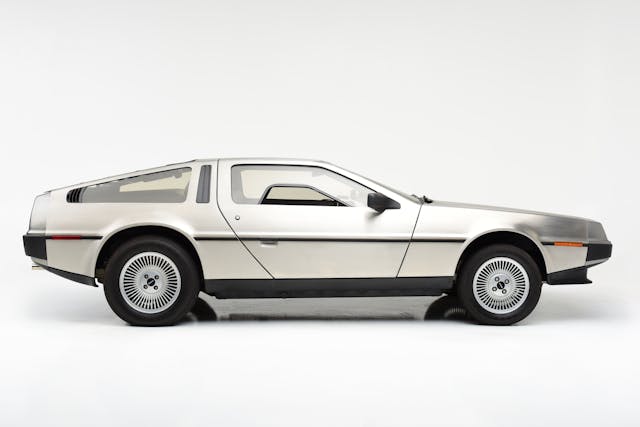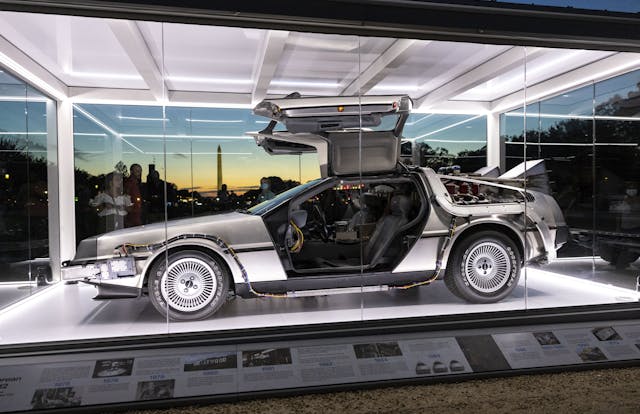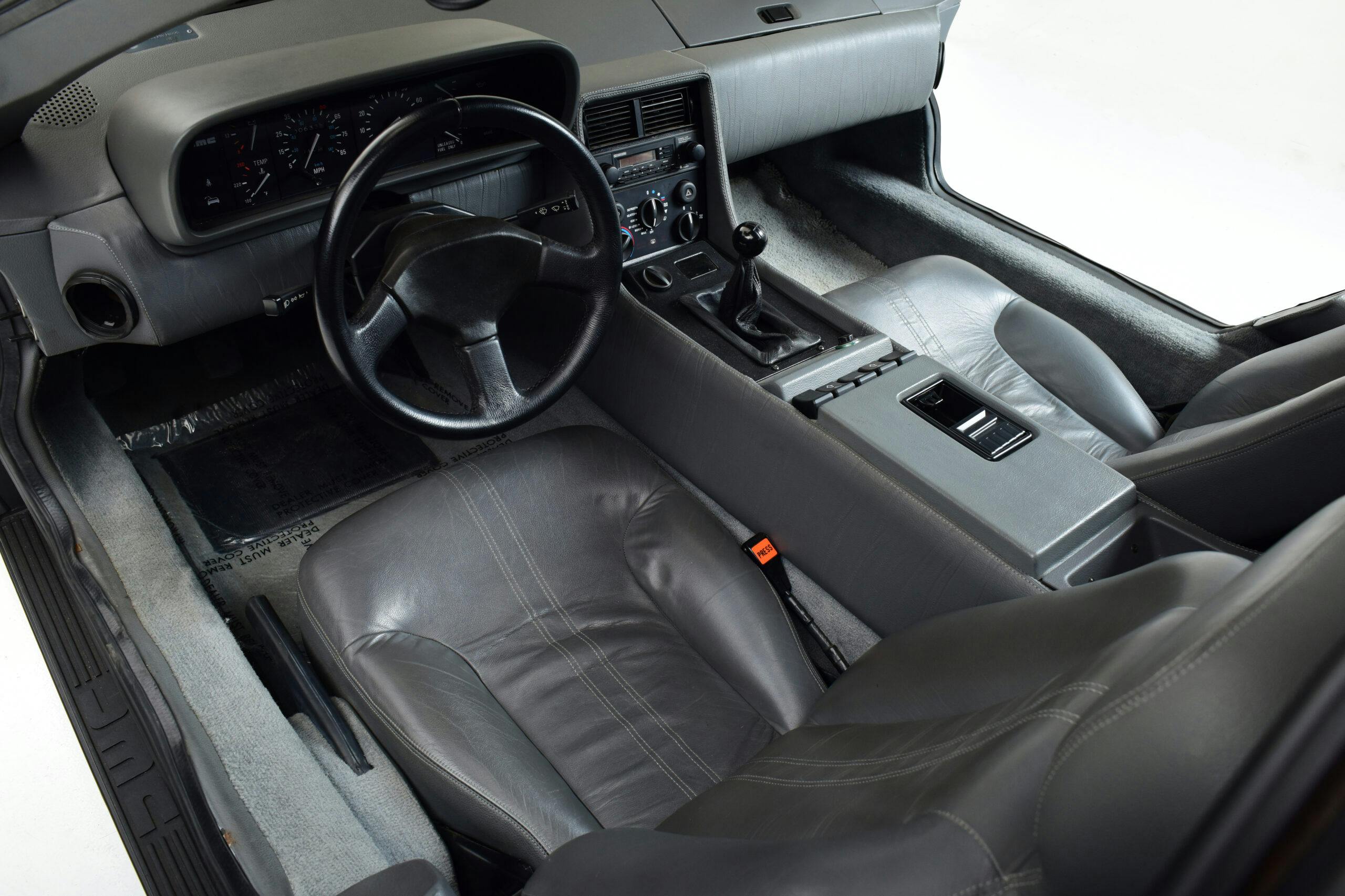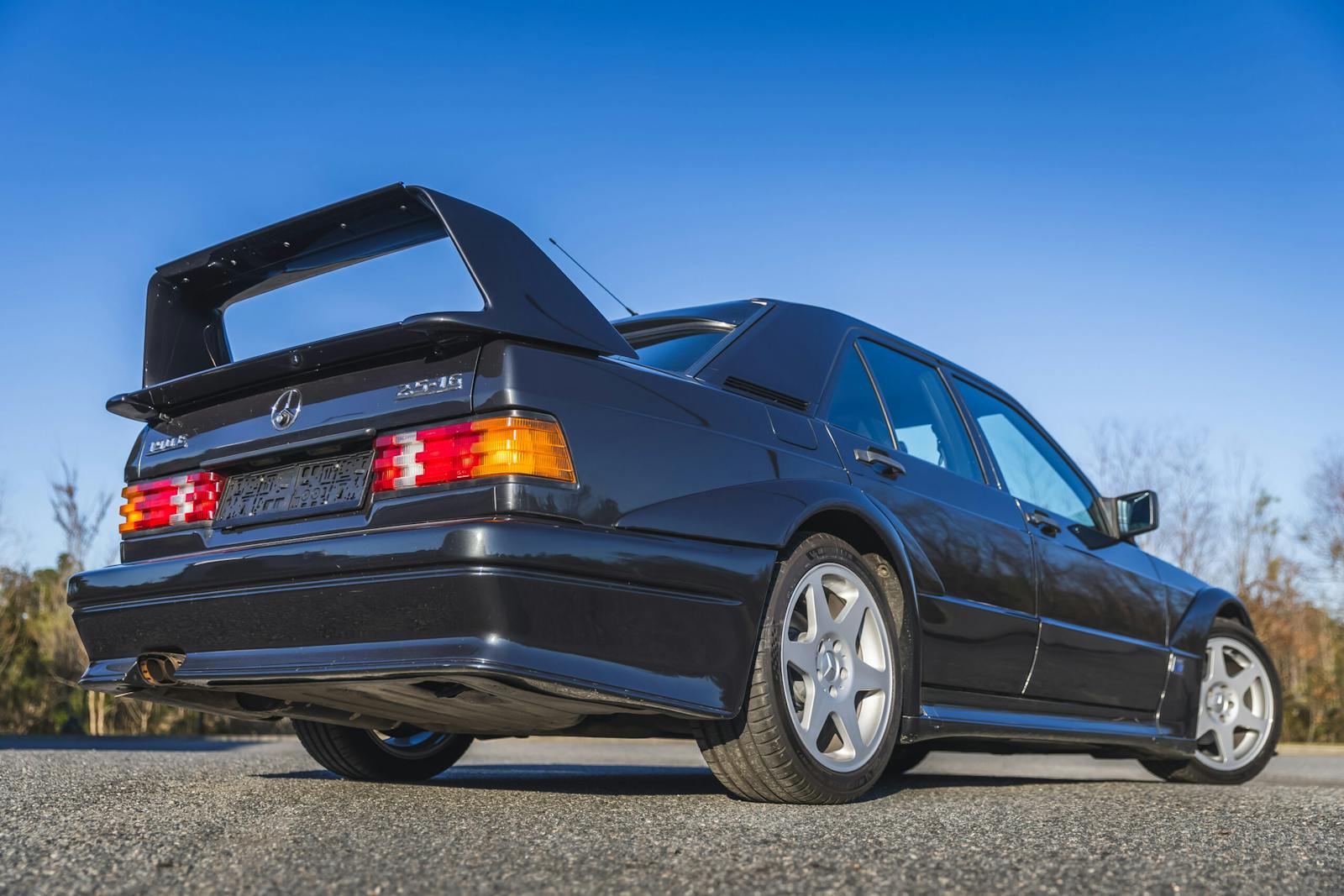DeLorean’s DMC-12 blazed an 88-mph path to collector status
DeLorean Motor Company, founded in 1975, was the most famous automotive flop since Tucker. Embroiled in scandal and allegations of fraud, the company came crashing down after its founder, John Z. DeLorean, was arrested in 1982, the target of a drug-trafficking sting operation. When the car factory shut down, angry workers chucked tooling into the ocean. The DeLorean-built vehicle was a rolling punchline when Hollywood chose one as Doc Brown’s 88-mph time machine in Back to the Future, which hit theaters in 1985. But the 38 years—has it really been that long?—since the movie’s debut have been kind to DeLorean’s only model, the DMC-12. Very kind, all things considered.
A starring role as the most famous movie-car ever (other than, maybe, James Bond’s Aston Martin) certainly helps. The cultural relevance of the Back to the Future DeLorean is so massive that it in 2021 was added to the National Historic Vehicle Register. The market for the cars is healthy, the community around them is vibrant and multigenerational, the aftermarket support for them is vast, and “new” DeLoreans are in the works thanks to the founder’s daughter. Can you say that about any other low-volume carmaker that went bust 40 years ago?

The DeLorean story is a good one, with lots of layers and many different perspectives. It has also been told many times by better, smarter writers than I, but here’s a short(ish) version. John Zachary DeLorean was the son of a Romanian-born Ford worker, but it was at General Motors that he became a golden boy. The youngest man to head a division at GM (Pontiac), he presided over the development and production of the GTO, which ignited the muscle-car explosion of the ’60s. He then headed up Chevrolet starting in 1969. Then, instead of climbing further up the GM ladder, he resigned in 1973 to start his own car company.
DeLorean met with Giorgetto Giugiaro in 1974 to pursue one of the Italian designer’s signature wedge shapes, his main wishes being for a car with an engine in back, gullwing doors, and stainless steel body. A prototype DeLorean called the DSV-1 (DeLorean Safety Vehicle) was ready in 1976. Under the skin, though, significant revisions to the structure were needed, and for this DeLorean turned to Colin Chapman and the chassis masters at Lotus. The team used a backbone very similar to the one on the Esprit, onto which a fiberglass body was mounted, and then stainless steel panels on top of that.
A planned Citroën/NSU rotary engine was also abandoned due to lack of availability, and instead DeLorean chose the 2849-cc Peugeot-Renault-Volvo (PRV) V-6, mounted in the rear and mated to either a five-speed manual or a three-speed automatic. U.S.-spec cars made 130 hp, Euro cars 155. Double wishbones with coil springs and telescopic shocks make up the suspension at the front, while the rear is a multi-link system, also with coil springs and telescopic shocks. Nearly two-thirds of the weight is at the back.

In 1978, DeLorean got $12.5M in investment capital from high-profile folks like Sammy Davis Jr. and Pan Am boss Juan Trippe. He had also talked the British government into backing the construction of his factory in Troubles-era Northern Ireland, and the facility opened in 1980 in Dunmurry, near Belfast, providing desperately needed jobs for 1000 workers.
In April 1981, the first batch of U.S.-market cars arrived in Long Beach. The car’s official name, DMC-12, referred to the target price of 12 grand, but base price had ballooned to around $25K—about $81K in today’s money. MSRP eventually grew to $29,825 in 1983 and again to $34K in 1983. No domestic-based upstart had successfully gone up against the Big Three in decades, and despite the price increase, it was easy for people to root against the old guard and cheer on the new kid on the block.
That included the fine folks in the automotive media. “Our first impressions are overwhelmingly positive,” said Car and Driver. “The handling is safe and satisfying, the V-6 engine surprisingly mellow in its newest assignment. The interior is roomy, comfortable, and reasonably well thought out. Most important, the DeLorean passes the critical enthusiast’s test: it’s fun to drive.”
Road & Track lamented the lack of straight line oomph, concluding it was more GT than sports car, but added “the engine’s flexibility makes up for its lack of brute horsepower.” R&T was also surprised to find it “has none of the kit-car feel that many critics expected,” and with more than a bit of prescience surmised that “it may well be that the DeLorean will become a cult car, purchased for status reasons by persons wishing to be seen as individualists.”
Despite the reviews, however, the cars weren’t selling well. Funding dwindled, and a plan to restructure the company and take it public didn’t pan out. The DeLorean Motor Cars went into receivership, just in time for the launch of a new line of DeLorean-branded men’s toiletries.
In December 1982, Colin Chapman—not long after answering tough questions about missing money from his deal with DeLorean, but before he could get into serious trouble—suddenly died of a heart attack at age 54. Group Lotus’s finance director Fred Bushell was very much alive, however, and he was sentenced to three years in jail. John DeLorean, meanwhile, had been arrested in 1982 while trying to raise capital in the infamous FBI cocaine-trafficking sting operation, “Operation Full Circle.” After a five-month trial, the jury concluded DeLorean was a victim of entrapment and found him not guilty. A grand jury in Detroit also found him not guilty on multiple counts of fraud, racketeering, and tax evasion.
The ruling in the court of public opinion was another story. Despite a brilliant career, DeLorean became the eternal butt of cocaine jokes, and the former industry superstar never had another successful car venture, despite trying. He spent much of the rest of his life in and out of court and eventually sold his massive estate in Bedminster, New Jersey to a golf-course developer. In time, it wound up in the hands of Donald Trump.
The car of course was a big screen star, and DeLoreans became easily as much movie props and symbols of ’80s excess as they were cars. Only about 9000 were built, and yet everybody knows what a DeLorean is when they see one. Does everybody want to own it? Of course not, but plenty of people do, and owning one can be surprisingly easy for an orphan performance car like this. Since parts, service, restoration and entire cars are available from the modern DeLorean Motor Company. Otherwise known as Classic DMC, it is a firm north of Houston that acquired the original company’s parts inventory, factory drawings, and logo. It also manufactures new and improved DeLorean parts. The community of DeLorean lovers is also vast, passionate and knowledgeable, and doesn’t take itself too seriously.
Always culturally relevant but not always for the right reasons, DeLoreans haven’t really been cheap for a long time, just inexpensive relative to their rarity, fame, and the segment of the market they occupied when new. Like so many cars in the 2010s and especially during the 2020s, though, DeLoreans have ridden the ’80s nostalgia synthwave. As Gen Xers who want to unleash their inner Marty McFly approach their peak earning years, the cars have gotten more expensive. Over the last five years, condition #2 (Excellent) values are up 75 percent. It’s nearly tripled over the past 10, and currently it sits at $75,800. A solid #3 (Good) driver is a 50 grand prospect now, and even scruffy #4 (Fair) cars will set you back $33K. That’s a few grand less than current values for the Porsche 911 SCs this gullwing wonder shared the roads with back in its heyday. And, in case you’re wondering, a Bricklin is only worth about half as much as a DeLorean, despite the two cars being so similar in concept, history, and failure in period.
Without too many options in the catalog there isn’t a whole lot of variation in price not related to condition and mileage, but knock off a few percent for an automatic transmission, and generally the gray interiors are more desirable than the black ones. Cracks in the dash are common and those marvelous doors sometimes need a little extra help to open all the way, thanks to their fancy (deep breath) Grumman Aerospace–developed cryogenically preset torsion bars with gas-charged struts. Otherwise, the interiors generally hold up well. Power steering is a popular upgrade these days since the cars didn’t come with it new, and some relatively common issues include power window motors, alternators, and minor electrical gremlins. The engine may have been built in France and certainly isn’t a tire scorcher, but it is regarded as a reliable unit when maintained. As for that Lotus chassis, they were epoxy-dipped when new to prevent rust, but it’s been decades since then and the epoxy can crack, so rust is a real and difficult to detect possibility.
Most DeLoreans were sold in America, but the cars are world famous and a few have been exported. Despite their factory home in the UK, only somewhere around 15 DeLoreans were sold in right-hand drive, converted in period by a third party. There’s also something of a separate market for well-done clones of the Back to the Future time machine, and they can sell for prices as big as the car show crowds they’ll inevitably draw. Two have sold on Bring a Trailer for over $150K.

As for the regular old DMC-12s that don’t have a flux capacitor, though, they’re still popular with a wide set of enthusiasts. Unsurprisingly, a lot of buyer interest comes from Gen Xers, with 41 percent of DeLorean insurance quotes coming from that generation. But they’re also popular with millennials, the older members of which had a taste of the ’80s and the Back to the Future sequels.
The DeLorean had plenty of ingredients to be a footnote of automotive history. It was short-lived. It wasn’t a groundbreaking performer. But those movies and the salacious story behind the cars are the double stack of cultural relevance that keeps these cars desirable. Unlike many collector cars, people don’t buy a DeLorean because it’s a revelation to drive, because it won some famous race, or because their dad had one. They buy it for the image, the history, and the doors.
***
Check out the Hagerty Media homepage so you don’t miss a single story, or better yet, bookmark it. To get our best stories delivered right to your inbox, subscribe to our newsletters.





Just like anything in this world, it’s only worth what someone is willing to pay.
That’s One Helluva Observation !!!!!
Very nice article on a car and brand that is always of interest to car enthusiasts.
In response to your question at the end of the second paragraph – you can say that about the Bricklin, although they went bust 50 years ago.
I bought mine 83 new in 1984 (before the movie). I suppose I’m one of only a few original owners still out there. Currently preforming my 40 year “scheduled maintenance” on the car with some performance upgrades. Just over 10k miles and it still looks factory fresh. I couldn’t be happier.
I love your story about buying your DeLorean new. Good for you!!
You left out Bill Collins expertise in the creation of this DeLorean vehicle.
Neglected to mention the epic movie “Framing John DeLorean.”
That was more of a docudrama about the man; not the car itself. Accordingly Hollywood script writers took some liberties with the truth.
Your comment about workers throwing tooling into the ocean is a myth. It’s also a myth that the British government threw tooling into the ocean as a “punishment “ as some believe.
The reality is that after the factory closed everything was auctioned off. Some of the dies used for body panels were purchased by a fishing company and used for weights for fishing traps. This fact is covered by several books written by former factory employees.
The cars official name is not “DMC 12.” That was a preproduction name that was dropped as soon as production began. The official name is “DeLorean”.
This is why you do not see DMC 12 anywhere on the car, in the owners manual, on the certificate of origin, on any of the ads printed after production began, etc.
Imagine what this could have been with the turbo motor they had been developing. It will always be a cool car.
Have you ever driven one?
Have you ever worked on one?
They are poorly engineered piles of junk, and slow.
Yep and Yep. Not impressive cars by any means,
The “north of Houston” reference made by the author, is either in Houston, or possibly Humble, TX. It’s certainly near the boundary of both cities.
I live less than 10 miles away from the site, and it is visible to see it, if you headed east bound on the Sam Houston Tollroad. It’s just past Highway 59 (future I-69). It’s possible to look down from the elevated freeway and see it, if you’re in the far right hand lane.
It’s in Humble, for sure. The only reason I mentioned the original one being in Alief (as opposed to just saying Houston) is because of my personal connection to it.
I am thinking about buy one of these cars next year; and doing a number of upgrades – including replacing the tired Renault engine with a 4 cylinder Ford Eco-Boost enginethat will pump out 310 HP.
Working in an auto repair shop just off the New Jersey Turnpike one night. A guy came in with one painted orange. I walked out to look at it because I was sure it was a DeLorean. I asked the guy why did you paint it? He said he wanted his car to be different. Can you imagine painting stainless steel? Different strokes for different folks?
I ran across one in a specialty car dealership that had been painted a dark blue. My assumption at the time was that it had sustained body damage at some point and it had been cheaper to do Bondo and a repaint than to address the stainless body work.
Who owns the one that was electroplated gold?
Hmm, isn’t the writer forgetting the very definition of an automotive flop, the EDSEL?
Painted DeLoreans were crashed.
I bought a new one for $19,000 in Los Angeles, paying an extra $1,000 for the last(third year of production) model, betting that I it might be worth more some day, as it was produced in much smaller numbers.
I was told it’s at the time, since the company had already gone under, that it was put together with leftover parts from the first two regular years of production.
My DMC was a 1983, I worked on the cold rolling mill in the USA, that rolled the .032″ type 304 stainless for customer British Steel. DeLorean had to buy everything from England mfg.companys. My car was built in December 1982, I had the Nov.1982 Time Life with John on the cover in Hand cuffs, so when my car was built the employees did not know if they were going to get paid for it, but dedicated as the employees were, they did not scrimp on the quality of my car. One of my first questions how do I clean this thing. So I asked the guards at my employer that owned multiple Ford stainless cars, the 36 Ford,59 TBird and Continental convertable. The guards had the duty of taking care of them. He said windex and paper towels. No soap and water. So I bought a bottle of that and Bounty paper towels. Wall-a! In 5 to 10 minutes, from top to the wheels and tires looked show room new. Kept a bottle and a roll in the front trunk always. The biggest problem were the finger prints. If it was parked un attended anywhere, finger prints was on it people had to touch it. I took it to Ocean City Maryland and was parked in a front lot space at a beach side nice hotel. I went to use the car and was totally covered in tan lotion or sun screen finger prints, popped trunk sprayed down with Windex, wiped with the quicker picker upper and wall-a into the future! Thanks Bounty and Windex and that guard from work.
My only aerospace experience with the car was the first time the car would not start and had it flat towed home. I pulled the fuel pump out from the fuel cell and turned key on got nothing.
Had to pay $50.00 on credit card for a over the phone diagnosis of the electrical problem to a tech from Turbo Town, in Ft Lauderdale, Fl. Using a cordless telephone, had me try messing with the multiple array of relays. Well it ended up having Chafing, just like the Fly by wire problem in the fighter jets of the 1980’s. The interior was like a fiberglass compartment sandwiched against steel and wiring was within the sandwich. So the wire to the fuel pump had zero access to repair it. So the car would need disassembled meaning tub removed to access the wire. Talk about a O Hell No Moment! Thanks to the Turbo town tech identifying what relay I need to jumper to, and a spool of black wire, I ran a wire into engine compartment, under the car up to the trunk and upto the fuel pump.
Turned key, car fired right up! Wall-a! Im done I Run! Best $50.00 bucks ever spent… Really guy’s use your imagination, best $50.00 EVER Spent!
On my strike 3 you are out this was the first, you will not believe strike 2 and OMG number 3. In pic #3 is part of the result from strike number 3, and for sale sign in window. That story is a super long one but Jaw Dropping and 100% true.
Hey like my 1980’s pro custom Land Scape pic. I picked up a bail of straw or hay at land scape place for covering over new grass seed in surrounding the land scape, it fit in passenger seat of the Delorean, hay hauler added to it’s credentials. Sorry it won’t let me upload my photo’s, sorry all..